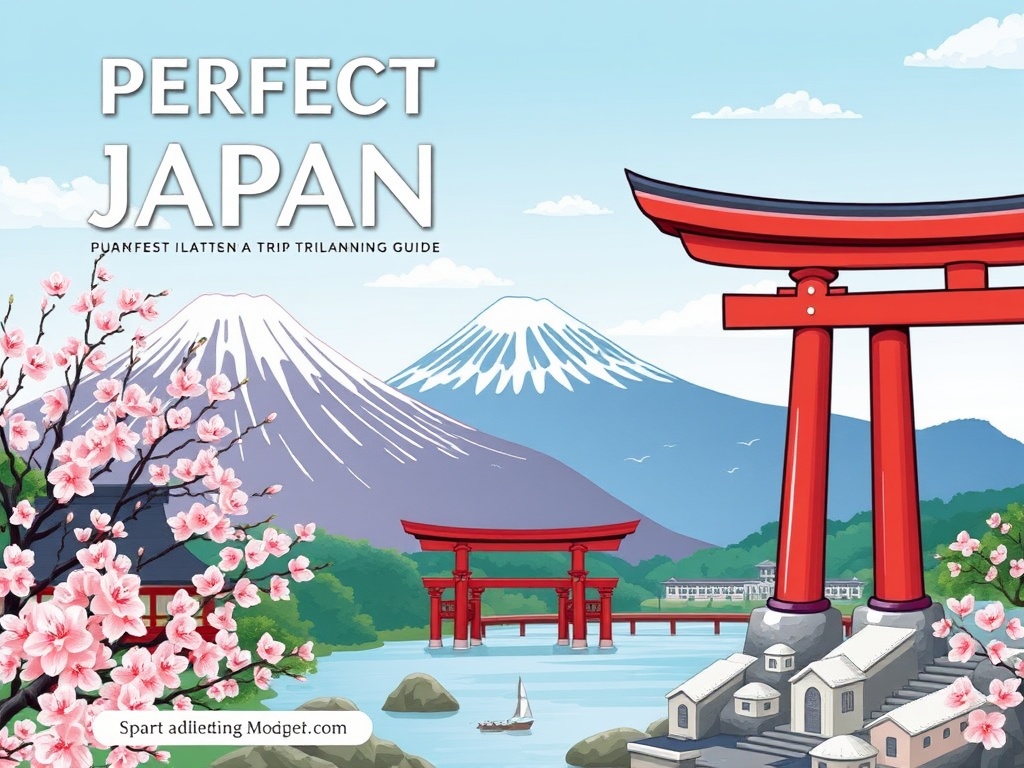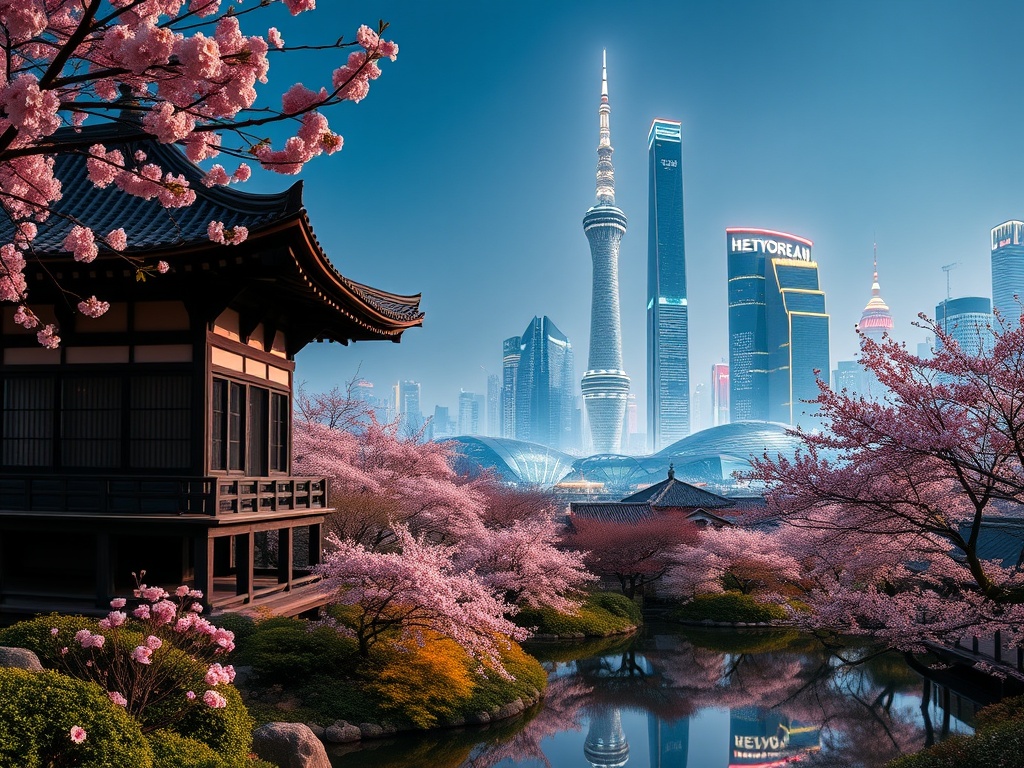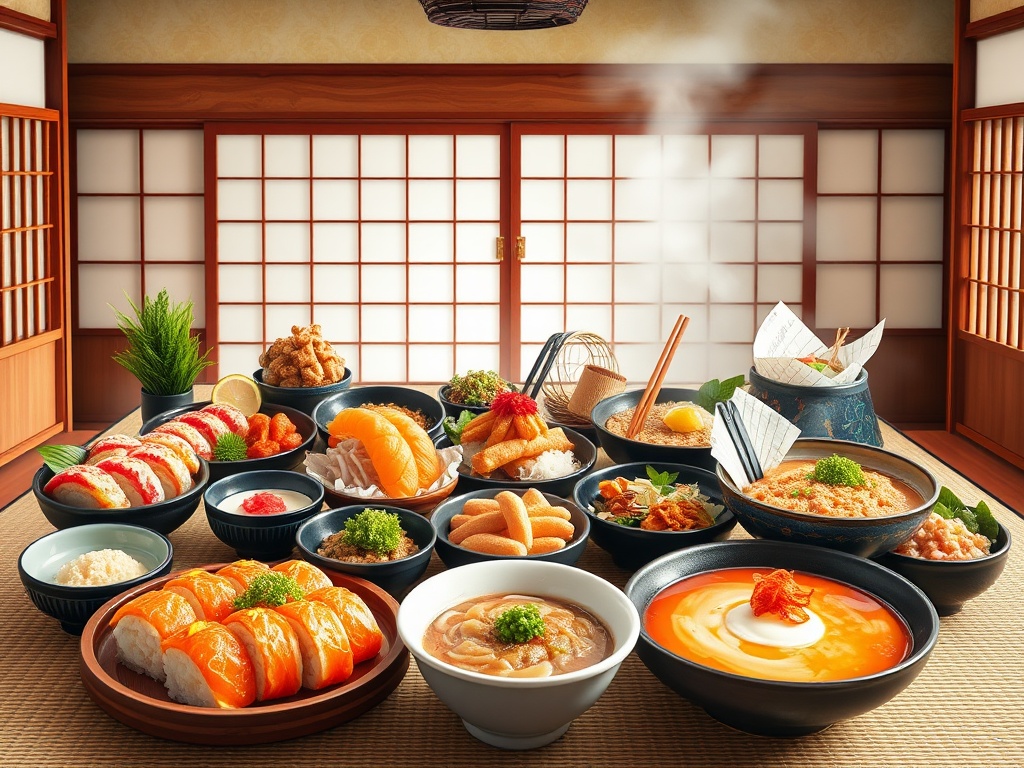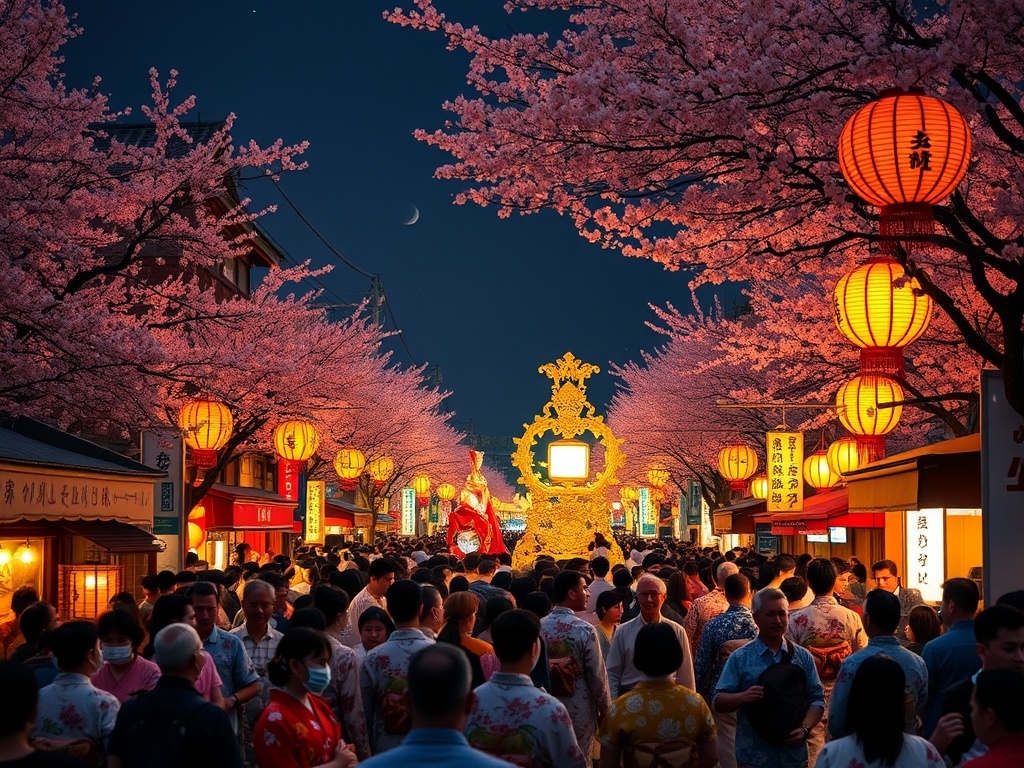Unveiling Japan: A Land of Timeless Traditions and Futuristic Wonders
Win a Free Trip to Japan!
Experience cherry blossoms and ancient temples
Japan is a mesmerizing blend of ancient traditions and cutting-edge technology, offering travelers an unforgettable journey through its rich cultural tapestry. Whether you’re wandering through tranquil temples or experiencing the neon-lit streets of Tokyo, Japan promises a unique adventure for every explorer. Let’s delve into the must-see wonders and experiences that await you in this captivating country.
Japan’s deep-rooted traditions offer a window into its past. From the serene landscapes of Kyoto to the historic streets of Kanazawa, these timeless destinations provide a glimpse into Japan’s cultural heritage.
- Kyoto’s Tranquil Temples: Known as the cultural heart of Japan, Kyoto is home to stunning temples like Kinkaku-ji and Fushimi Inari Shrine, where you can immerse yourself in the serenity of Zen gardens.
- Traditional Tea Ceremonies: Experience the art of the Japanese tea ceremony, a ritual that reflects the country’s devotion to harmony, respect, and tranquility.
- Historic Kanazawa: Wander through the well-preserved samurai and geisha districts of Kanazawa, a city that offers a rich tapestry of history and culture.
While Japan honors its past, it also stands at the forefront of technological innovation and futuristic marvels. Cities like Tokyo and Osaka offer a glimpse into the future with their incredible landscapes and innovations.
- Tokyo’s Neon Dreams: Explore the bustling streets of Shibuya and Shinjuku, where skyscrapers and neon lights create a surreal urban experience.
- High-Tech Marvels: Visit the Miraikan Museum in Tokyo for an interactive journey into the world of robots, space exploration, and cutting-edge technology.
- Osaka’s Vibrant Energy: Discover the lively atmosphere of Dotonbori, where vibrant signs and culinary delights await every visitor.
List of Essential Experiences: From tasting fresh sushi at Tsukiji Market to soaking in an onsen, these experiences encapsulate the essence of Japan.
- Indulging in authentic sushi at Tsukiji Market
- Relaxing in a traditional Japanese onsen
- Taking part in a local festival, such as the Gion Matsuri in Kyoto
- Exploring the ancient castles of Himeji and Matsumoto
Japan’s allure lies in its ability to seamlessly blend the old with the new, creating a travel experience that resonates with the soul. Whether you’re a history buff, a tech enthusiast, or simply an adventurer at heart, Japan is a destination that promises to enchant and inspire.
Culinary Odyssey: Savoring the Flavors of Japan’s Diverse Cuisine
Embarking on a culinary journey through Japan is akin to exploring a vibrant tapestry of flavors, each dish offering a story of tradition, innovation, and regional diversity. From the bustling streets of Tokyo to the serene countryside of Hokkaido, Japan’s culinary landscape promises an unforgettable gastronomic adventure that is sure to captivate even the most discerning palate.
Japan’s cuisine is as diverse as its geography, with each region boasting unique dishes that reflect its local culture and ingredients. In the north, Hokkaido is renowned for its fresh seafood and dairy products, offering delights such as buttery uni (sea urchin) and the creamy richness of its famed milk and cheese. Meanwhile, the warm waters of Okinawa in the south provide a bounty of tropical produce, resulting in vibrant dishes that fuse Japanese and Southeast Asian influences.
The bustling metropolis of Osaka, known as the nation’s kitchen, offers a delightful array of street food that captures the essence of Kansai cuisine. Treat yourself to savory okonomiyaki, a Japanese pancake filled with cabbage and a variety of savory toppings, or savor the iconic takoyaki, crispy octopus balls that melt in your mouth. Each bite tells a tale of the city’s lively spirit and culinary creativity.
Japan invites travelers to not only taste its culinary delights but to also immerse themselves in the cultural rituals surrounding food. The traditional kaiseki dining experience offers a multi-course meal that is as much a visual feast as it is a culinary one. Each meticulously crafted dish showcases seasonal ingredients in their purest form, reflecting the Japanese philosophy of harmony and balance.
For those seeking a more interactive experience, consider visiting an izakaya, a lively Japanese pub where locals gather to unwind over a medley of small plates and sake. Here, you’ll find a warm and inviting atmosphere where you can sample a variety of dishes, from skewered yakitori to sashimi, each paired perfectly with the house’s recommended drink.
Cultural Immersion: Experiencing Japan’s Festivals and Rituals
Immersing yourself in Japan’s vibrant festivals and age-old rituals offers a profound understanding of its cultural heartbeat. This is where the country’s rich heritage and modern dynamism converge, unveiling experiences that are as enlightening as they are enchanting. Whether you’re a curious traveler or an avid cultural enthusiast, participating in these events can be the highlight of your journey, offering insights into the Japanese way of life that are both authentic and unforgettable.
Japan’s festivals, or matsuri, are more than just a spectacle; they are a living testament to the nation’s deep-rooted customs and communal spirit. One of the most famous is the Gion Matsuri in Kyoto, a month-long celebration held every July. With its stunning parade of yamaboko floats and lively street festivities, it showcases the city’s artistic and cultural opulence. Similarly, the Awa Odori in Tokushima is a dance festival that fills the streets with infectious energy and colorful costumes, inviting both locals and visitors to join in the joyous revelry.
In the chill of winter, the Sapporo Snow Festival in Hokkaido transforms the city into a winter wonderland, featuring awe-inspiring ice sculptures and light displays. Each festival offers a unique opportunity to witness Japan’s seasonal beauty and the harmonious blend of past and present that defines its cultural landscape.
Beyond the vibrant festivals, Japan’s rituals offer a more intimate look at its spiritual and social fabric. The Shinto and Buddhist practices that permeate daily life are particularly enlightening. A visit to a local shrine or temple provides a chance to observe or partake in rituals such as purification and prayer, fostering a sense of peace and reflection.
One cannot overlook the significance of Hanami, the cherished tradition of flower viewing, which celebrates the fleeting beauty of cherry blossoms each spring. This ritual is a perfect example of the Japanese appreciation for nature’s transient nature, where picnicking under the blooms becomes a communal act of gratitude and reverence.
Engaging in these festivals and rituals not only enhances your travel experience but also fosters a deeper connection with Japan’s cultural essence, allowing you to return home with cherished memories and a newfound appreciation for this extraordinary land.
Nature’s Canvas: Discovering Japan’s Stunning Landscapes and Gardens
Japan’s natural beauty is a mesmerizing tapestry of landscapes that captivate the senses and inspire the soul. From the majestic mountains and tranquil gardens to the lush forests and serene lakes, Japan’s diverse natural wonders offer a retreat from the bustling urban life, inviting travelers to immerse themselves in the country’s breathtaking scenery. Whether you’re an avid hiker, a photography enthusiast, or simply seeking peace and tranquility, Japan’s landscapes and gardens promise an unforgettable journey into nature’s embrace.
The Japanese Alps stretch across central Honshu, offering some of the most impressive landscapes in the country. These mountains are not only a haven for adventure seekers but also a sanctuary for those seeking solitude and reflection. Trekking through the Kamikochi Valley, you can marvel at the towering peaks, crystal-clear rivers, and abundant wildlife, all of which contribute to an otherworldly experience. In winter, the mountains transform into a snowy paradise, attracting skiers and snowboarders from around the world.
Another must-visit is Mount Fuji, Japan’s iconic symbol of natural beauty. Standing at 3,776 meters, it is both a spiritual and cultural emblem. Climbing Mount Fuji is a revered pilgrimage, offering panoramic views that reward every step of the ascent. Even from afar, the sight of Mount Fuji’s symmetrical cone against the sky is a scene that stays with you forever, a testament to Japan’s enchanting landscapes.
Japan’s gardens are masterpieces of art and nature, crafted with meticulous care to reflect the seasons and the principles of harmony. Kenroku-en in Kanazawa is one of the most celebrated gardens, known as a ‘landscape garden’ that combines six attributes: spaciousness, seclusion, artifice, antiquity, watercourses, and panoramas. Walking through Kenroku-en, visitors can experience a sense of serenity and balance, a perfect escape into nature’s own canvas.
In Kyoto, the Ryoan-ji Temple’s rock garden offers a minimalist beauty that invites contemplation and introspection. The simplicity of its design, with carefully arranged rocks and raked gravel, embodies the Zen philosophy of simplicity and tranquility. Meanwhile, the gardens of the Imperial Palace in Tokyo offer a lush oasis in the heart of the city, showcasing a stunning array of seasonal flowers and traditional structures that transport visitors to a bygone era.
Every garden and landscape in Japan tells a story of nature’s artistry and human ingenuity, providing a unique glimpse into the country’s profound connection with its natural environment. Embracing these stunning vistas not only enriches your travel experience but also offers a deeper understanding of Japan’s cultural soul.
Urban Expeditions: Navigating the Vibrant Cities of Japan
Embarking on an urban expedition through Japan’s vibrant cities is like stepping into a world where tradition harmoniously coexists with the modern age. Each city pulsates with its own distinct rhythm, offering an array of experiences that are as diverse as the landscapes themselves. From the dynamic pulse of Tokyo to the cultural elegance of Kyoto, Japan’s urban centers are filled with endless opportunities for discovery and adventure.
Tokyo, the bustling capital, is a mesmerizing blend of futuristic innovation and cultural tradition. Begin your journey in Shibuya, famous for its iconic scramble crossing and vibrant fashion scene. As you navigate through the neon-lit streets, you’ll find a perfect blend of modernity and history around every corner. Be sure to visit Asakusa for a taste of old Tokyo, where the historic Senso-ji Temple and traditional markets capture the city’s timeless charm.
For a dive into the world of technology, a visit to Akihabara is a must. Known as the electronics district, it’s a paradise for tech enthusiasts and anime aficionados alike. Explore the multi-level stores brimming with the latest gadgets and immerse yourself in the vibrant otaku culture that defines this unique neighborhood.
In stark contrast to Tokyo’s hustle and bustle, Kyoto offers a serene escape into Japan’s historical heart. Wander through the cobbled streets of Gion, where the sight of geishas gracefully walking to their appointments is a common delight. The city is home to an impressive array of UNESCO World Heritage Sites, including the tranquil Kinkaku-ji, also known as the Golden Pavilion, which offers a picturesque reflection on its surrounding pond.
For an immersive cultural experience, participate in a traditional tea ceremony or explore the ancient Nijo Castle. Kyoto’s dedication to preserving its rich cultural heritage makes it an essential stop for anyone looking to connect with Japan’s storied past.
Here is a list of must-visit highlights that showcase the unique charm and diversity of Japan’s cities:
- Osaka’s Dotonbori: A bustling hub of street food and entertainment, perfect for foodies and night owls.
- Nagoya’s Science Museum: Home to one of the world’s largest planetariums, offering an awe-inspiring journey through the cosmos.
- Fukuoka’s Canal City: A vibrant shopping and entertainment complex that includes a stunning water fountain show.
Whether you’re drawn to the historical allure of Kyoto or the innovative spirit of Tokyo, Japan’s cities promise a kaleidoscope of experiences that will captivate and inspire every traveler.
Historical Trails: Journey Through Japan’s Rich Past
Embarking on a journey through Japan’s historical trails is like stepping into a living museum, where every path and stone tells a story of the nation’s storied past. As you traverse these ancient routes, you’ll discover the echoes of Japan’s samurai, emperors, and artisans, each leaving an indelible mark on the cultural landscape. This journey offers a profound connection to the spirit of Japan, one where history is not just seen, but felt with every step.
The legacy of the samurai, Japan’s legendary warrior class, is intricately woven into the country’s fabric. As you wander through the historic streets of Kanazawa, the well-preserved Nagamachi Samurai District invites you to explore the traditional homes and atmosphere of the Edo period. Here, the past is vividly alive, offering insights into the samurai’s disciplined lifestyle and unwavering sense of honor.
In the city of Kumamoto, the imposing Kumamoto Castle stands as a testament to the architectural prowess and strategic ingenuity of the samurai era. Walking through its formidable gates and walls, you can almost hear the clatter of armor and the echoes of past battles. These sites provide a fascinating window into the martial artistry and cultural significance of Japan’s bravest warriors.
Kyoto, once the imperial capital, is a city steeped in tradition and history, where the grandeur of the past is preserved in its temples and palaces. The majestic Kyoto Imperial Palace offers a glimpse into the opulent lifestyle of Japan’s emperors, with its intricate architecture and serene gardens. A stroll through the palace grounds is a journey through time, where the elegance of the Heian period comes to life.
Not to be missed is the Nijo Castle, a UNESCO World Heritage Site, renowned for its beautiful gardens and the iconic ‘nightingale floors’ that sing underfoot. These historical treasures provide a captivating narrative of Kyoto’s role as the heart of Japanese culture and governance, where the echoes of emperors and courtiers can still be heard.
Exploring Japan’s historical trails is not just about visiting sites; it’s an immersive experience that connects you with the essence of the nation’s past. Each destination is a chapter in Japan’s rich history, waiting to be discovered and cherished by those who walk its storied paths.
Zen and Serenity: Uncover the Tranquility of Japan’s Sacred Sites
For travelers seeking a sanctuary of peace and reflection, Japan’s sacred sites offer a unique opportunity to experience the nation’s spiritual essence. These sites are not only places of worship but also symbols of Japan’s deep connection with nature and tranquility. From the mist-covered mountains to the serene coastal shrines, each location is a beacon of calm, inviting visitors to step away from the chaos of modern life and into a realm of zen and serenity.
Perched high in the mountains of Wakayama Prefecture, Mount Koya is a sacred retreat that has been a center of Buddhist study and worship for over a millennium. This spiritual haven is home to over a hundred temples, many of which offer lodging to visitors seeking a monastic experience. As you wander through the tranquil grounds, you’ll encounter the ancient Okunoin Cemetery, where towering cedar trees guard the resting place of Kobo Daishi, the founder of Shingon Buddhism.
Staying overnight in one of the temple lodgings, known as shukubo, allows you to participate in morning prayers and savor traditional vegetarian meals, known as shojin ryori. This immersive experience provides a profound sense of peace and offers a rare glimpse into the monastic lifestyle, making Mount Koya an essential pilgrimage for those in search of inner tranquility.
Ise Grand Shrine, or Ise Jingu, is one of Japan’s most revered Shinto shrines, dedicated to the sun goddess Amaterasu. Nestled within the ancient forests of Mie Prefecture, this sacred site embodies the purity and simplicity of Shinto beliefs. The shrine’s architecture is a masterpiece of traditional design, reconstructed every twenty years to symbolize the Shinto concept of renewal and impermanence.
Visitors to Ise Jingu are enveloped in a serene atmosphere, as the gentle rustling of leaves and the distant sounds of nature create a symphony of tranquility. Walking along the gravel paths, you’ll find yourself drawn into a deeper connection with nature, experiencing the spiritual harmony that has been cherished by pilgrims for centuries.
Exploring these sacred sites not only enriches your understanding of Japanese spirituality but also offers a chance to unwind and reflect in some of the country’s most serene environments. Embrace the tranquility of Japan’s sacred sites and uncover the zen that lies at the heart of this fascinating land.



